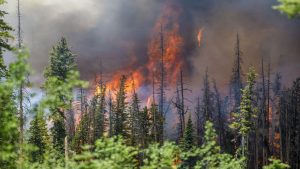Ask Eartha: What is Summit County doing to fight climate change?
Dear Eartha,
I recently visited a friend in the Front Range, and her community is doing a lot to fight climate change. What’s going on in Summit County? -Michelle, Frisco
Michelle, I love having the opportunity to chat about climate not only because it’s such an important issue for the global community, but also because we need to talk about it more. Did you know that 70 percent of Americans agree that climate change is happening? Yet only 36 percent of us talk about it on a regular basis. That sends a message, don’t you think?
Of course, most of us would rather not have conversations about big scary topics because no one likes feeling uncomfortable. But when we don’t talk about climate change, our silence works to convince ourselves and others that it’s not worth talking about – that it’s not a big deal. The impacts are far away in time and location, and we can just put it on the backburner.
Unfortunately, that’s not the case.
The impacts are here – we can see them across Colorado. In fact, some of my friends who are long-time locals of Summit County think that the recent storm cycle we had – the one that caused the avalanche on Peak 1 – well, they think this storm is a sign of what’s to come because warmer air holds more moisture. So as average temperatures across the state continue to rise, snow will become wetter and heavier as a result, leading to more frequent avalanches. A climate-changed future also brings increased risk of wildfire, drought, and heat waves, impacting people and industries across the state.

Ten-Mile Creek flows into the Dillon Reservoir
Since the United States announced its intention to withdraw from the Paris Climate Agreement, communities across the country have become champions in the fight against climate change. In fact, 282 cities and counties plus 10 states have publicly committed to upholding the goals of the agreement. These communities represent nearly half the US population, which means a lot of us are creating positive change at home.
Climate Action in Summit County
So, what are we doing locally? Last year, a group of stakeholders representing our local governments, ski areas, educational institutions, utilities, and large business came together to form the Summit Climate Action Collaborative. This group spent six months analyzing local greenhouse gas emissions and devising strategies to reduce them. The result of all this effort is the Summit Community Climate Action Plan, which you can check out for yourself at HighCountryConservation.org.
Aligned with the Paris Agreement, the plan sets a goal to reduce emissions in Summit County 80 percent by 2050. How will we achieve this? Well, like most communities, our emissions largely come from energy use in buildings and transportation. Strategies in the plan focus on how to ensure that new construction is as energy efficient as possible, improve the efficiency of existing buildings, and support more renewable energy – both locally generated and provided by utility companies. We also want to make it easier for people to drive electric cars and think creatively about making public transit more convenient. Already our community has programs that incentivize energy efficiency, a free public transit system, and growing waste reduction programs.

Tuesday, June 12, in Silverthorne.
Climate Change: Simple, Serious, Solvable
To keep the climate conversation going, High Country Conservation Center is hosting a talk at CMC’s Breckenridge campus on April 3 from 6 – 7:30 PM. Scott Denning, an atmospheric scientist from Colorado State University, will give a presentation called “Climate Change: Simple, Serious, Solvable.”
In his presentation, Denning breaks down the science of climate change in a way that’s easy to understand and explains why it’s a problem that demands our attention. He’ll also engage the audience in a discussion of possible solutions. Not just any atmospheric scientist, Denning has served on advisory panels for NASA, NOAA, the US Department of Energy, and the National Science Foundation.
Count me in as one of the Americans who agrees that climate change is real and will negatively impact American lives. Rather than ignore it, I choose to face the hard work required to start solving the problem. My hope is that as our local governments and Climate Action Collaborative members adopt the plan, its goals and strategies become a regular part of our community conversations. And those conversations can involve the millions of folks that visit us each year, too.
We have an opportunity to lead by example, and to show other people that acting on climate change can simultaneously build community and create better amenities for both residents and visitors. Climate change gives us the opportunity to reimagine our future and create an even better Summit County, and that’s not scary at all.
Ask Eartha Steward is written by the staff at the High Country Conservation Center, a nonprofit dedicated to waste reduction and resource conservation. Submit questions to Eartha at info@staging.highcountryconservation.org.




